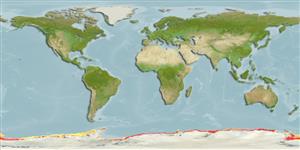Environment: milieu / climate zone / depth range / distribution range
Écologie
marin bathydémersal; profondeur 203 - 1145 m. Deep-water; 64°S - 78°S
Southern Ocean: Weddell Sea, Graham Land, Queen Mary Land, South Victoria Land.
Taille / Poids / Âge
Maturity: Lm ? range ? - ? cm
Max length : 13.7 cm TL mâle / non sexé; (Ref. 5181); poids max. publié: 13.90 g (Ref. 124149); poids max. publié: 13.90 g
Found on the sublittoral and continental shelf. Adults feed mainly on errant polychaetes; also in the gut content were gammarid amphipods, isopods, sedentary polychaetes and unidentified polychaetes (Ref. 5181).
Life cycle and mating behavior
Maturities | Reproduction | Spawnings | Egg(s) | Fecundities | Larves
Eakin, R.R., 1990. Artedidraconidae. p. 332-356. In O. Gon and P.C. Heemstra (eds.) Fishes of the Southern Ocean. J.L.B. Smith Institute of Ichthyology, Grahamstown, South Africa. (Ref. 5181)
Statut dans la liste rouge de l'IUCN (Ref. 130435)
Menace pour l'homme
Harmless
Utilisations par l'homme
Pêcheries: sans intérêt
Outils
Articles particuliers
Télécharger en XML
Sources Internet
Estimates based on models
Preferred temperature (Ref.
123201): -1.8 - 0.3, mean -1.1 °C (based on 981 cells).
Phylogenetic diversity index (Ref.
82804): PD
50 = 1.0000 [Uniqueness, from 0.5 = low to 2.0 = high].
Bayesian length-weight: a=0.00562 (0.00355 - 0.00891), b=3.08 (2.94 - 3.22), in cm total length, based on LWR estimates for this species & (Sub)family-body (Ref.
93245).
Niveau trophique (Ref.
69278): 3.2 ±0.38 se; based on food items.
Résilience (Ref.
120179): Milieu, temps minimum de doublement de population : 1,4 à 4,4 années (Assuming Fec < 10,000).
Fishing Vulnerability (Ref.
59153): Moderate vulnerability (38 of 100).
